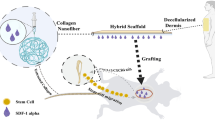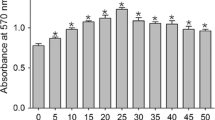Abstract
Nicotine has been reported to prolong the wound healing; however, we showed that the topical application of 10−4 M nicotine promoted murine wound healing. The objective of this study was to explore the wound healing effects of nicotine in combination with collagen scaffold using skin defects in rabbit. Three full-thickness skin defects 8 mm in diameter were made on the rabbit auricle. Artificial dermis was applied to the defects, and 10 μl of nicotine solution (10−5, 10−4, and10−3 M), bFGF solution (0.5 μg/10 μl), and both bFGF and 10−4 M nicotine solutions were injected into the artificial dermis once daily for 7 days. Rabbits were sacrificed on day 10, 15, or 20, and the wound healing process was evaluated. bFGF was superior in the formation of the dermis-like tissue and capillaries. In nicotine groups, the epithelial length and the dermis-like tissue formations in the 10−4 M group were superior, in contrast, those were inhibited in the 10−3 M group. The synergistic effect of bFGF and 10−4 M nicotine was not confirmed. This study suggests that the topical application of 10−4 M nicotine promoted wound healing in rabbit, but the effect was not apparent compared with murine models.





Similar content being viewed by others
References
Mosely LH, Finseth F. Cigarette smoking: impairment of digital blood flow and wound healing in the hand. Hand. 1977;9:97–101.
Spear SL, Ducic I, Cuoco F, Hannan C. The effect of smoking on flap and donor-site complications in pedicled TRAM breast reconstruction. Plast Reconstr Surg. 2005;116:1873–80.
Sorensen LT, Karlsmark T, Gottrup F. Abstinence from smoking reduces incisional wound infection: a randomized controlled trial. Ann Surg. 2003;238:1–5.
Sorensen LT, Zillmer R, Agren M, Ladelund S, Karlsmark T, Gottrup F. Effect of smoking, abstention, and nicotine patch on epidermal healing and collagenase in skin transudate. Wound Repair Regen. 2009;17:347–53.
Misery L. Nicotine effects on skin: are they positive or negative? Exp Dermatol. 2004;13:665–70.
Silverstein P. Smoking and wound healing. Am J Med. 1992;15:22S–4S.
Sherwin MA, Gastwirth CM. Detrimental effects of cigarette smoking on lower extremity wound healing. J Foot Surg. 1990;29:84–7.
Wong LS, Green HM, Feugate JE, Yadav M, Nothnagel EA, Martins-Green M. Effects of “second-hand” smoke on structure and function of fibroblasts, cells that are critical for tissue repair and remodeling. BMC Cell Biol. 2004;5:5–13.
Fang Y, Svoboda KK. Nicotine inhibits human gingival fibroblast migration via modulation of Rac signaling pathways. J Clin Periodontol. 2005;32:1200–7.
Heeschen C, Jang JJ, Weis M, Pathak A, Kaji S, Hu RS, Tsao PS, Johnson FL, Cooke JP. Nicotine stimulates angiogenesis and promotes tumor growth and atherosclerosis. Nat Med. 2001;7:833–9.
Arias HR, Richards VE, Ng D, Ghafoori ME, Le V, Mousa SA. Role of non-neuronal nicotinic acetylcholine receptors in angiogenesis. Int J Biochem Cell Biol. 2009;41:1441–51.
Morimoto N, Takemoto S, Kawazoe T, Suzuki S. Nicotine at a low concentration promotes wound healing. J Surg Res. 2008;145:199–204.
Liem PH, Morimoto N, Ito R, Kawai K, Suzuki S. Treating a collagen scaffold with a low concentration of nicotine promoted angiogenesis and wound healing. J Surg Res. 2013;182:353–61.
Suzuki S, Matsuda K, Isshiki N, Tamada Y, Ikada Y. Experimental study of a newly developed bilayer artificial skin. Biomaterials. 1990;11:356–60.
Suzuki S, Matsuda K, Nishimura Y, Maruguchi Y, Maruguchi T, Ikada Y, Morita S, Morota K. Review of acellular and cellular artificial skins. Tissue Eng. 1996;2:267–75.
Soejima K, Nozaki M, Sasaki K, Takeuchi M, Negishi N. Treatment of giant pigmented nevus using artificial dermis and a secondary skin graft from the scalp. Ann Plast Surg. 1997;39:489–94.
Molnar JA, DeFranzo AJ, Hadaegh A, Morykwas MJ, Shen P, Argenta LC. Acceleration of Integra incorporation in complex tissue defects with subatmospheric pressure. Plast Reconstr Surg. 2004;113:1339–46.
Matsuda K, Suzuki S, Isshiki N, Yoshioka K, Wada R, Hyon SH, Ikada Y. Evaluation of a bilayer artificial skin capable of sustained release of an antibiotic. Biomaterials. 1992;13:119–22.
Ito K, Ito S, Sekine M, Abe M. Reconstruction of the soft tissue of a deep diabetic foot wound with artificial dermis and recombinant basic fibroblast growth factor. Plast Reconstr Surg. 2005;115:567–72.
Muneuchi G, Suzuki S, Moriue T, Igawa HH. Combined treatment using artificial dermis and basic fibroblast growth factor (bFGF) for intractable fingertip ulcers caused by atypical burn injuries. Burns. 2005;31:514–7.
Gospodarowicz D, Neufeld G, Schweigerer L. Molecular and biological characterization of fibroblast growth factor, an angiogenic factor which also controls the proliferation and differentiation of mesoderm and neuroectoderm derived cells. Cell Differ. 1986;19:1–17.
McGee GS, Davidson JM, Buckley A, Sommer A, Woodward SC, Aquino AM, Barbour R, Demetriou AA. Recombinant basic fibroblast growth factor accelerates wound healing. J Surg Res. 1988;45:145–53.
Jacobi J, Jang JJ, Sundram U, Dayoub H, Fajardo LF, Cooke JP. Nicotine accelerates angiogenesis and wound healing in genetically diabetic mice. Am J Pathol. 2002;161:97–104.
Xanthoulea S, Deliaert A, Romano A, Rensen S, Buurman WA, van der Hulst RR. Nicotine effect on inflammatory and growth factor responses in murine cutaneous wound healing. Int Immunopharmacol. 2013;17:1155–64.
Booyse FM, Osikowicz G, Radek J. Effect of nicotine on cultured bovine aortic endothelial cells. Thromb Res. 1981;23:169–85.
Hill P, Haley NJ, Wynder EL. Cigarette smoking: carboxyhemoglobin, plasma nicotine, cotinine and thiocyanate vs. self-reported smoking data and cardiovascular disease. J Chronic Dis. 1983;36:439–49.
Gospodarowicz D, Ferrara N, Schweigerer L, Neufeld G. Structural characterization and biological functions of fibroblast growth factor. Endocr Rev. 1987;8:95–114.
Motomura K, Hagiwara A, Komi-Kuramochi A, Hanyu Y, Honda E, Suzuki M, Kimura M, Oki J, Asada M, Sakaguchi N, Nakayama F, Akashi M, Imamura T. An FGF1:FGF2 chimeric growth factor exhibits universal FGF receptor specificity, enhanced stability and augmented activity useful for epithelial proliferation and radioprotection. Biochim Biophys Acta. 2008;1780:1432–40.
Author information
Authors and Affiliations
Corresponding author
Ethics declarations
Conflicts of interests
There is no conflict of interest for all authors. Financial disclosure: this research was supported by a grant from the Smoking Research Foundation.
Rights and permissions
About this article
Cite this article
Masuoka, H., Morimoto, N., Sakamoto, M. et al. Exploration of the wound healing effect of topical administration of nicotine in combination with collagen scaffold in a rabbit model. J Artif Organs 19, 167–174 (2016). https://doi.org/10.1007/s10047-015-0873-6
Received:
Accepted:
Published:
Issue Date:
DOI: https://doi.org/10.1007/s10047-015-0873-6




